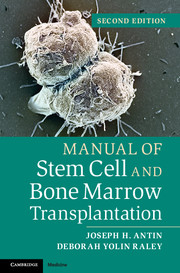Book contents
- Frontmatter
- Contents
- Acknowledgments
- Contributor
- 1 Rationale for transplantation
- 2 Types of transplantation
- 3 Human leukocyte antigen matching in allogeneic transplantation
- 4 Stem cell source
- 5 Pretransplant evaluation and counseling of patient and donor
- 6 Conditioning regimens
- 7 Stem cell infusion
- 8 ABO compatibility
- 9 Engraftment
- 10 Preventative care
- 11 Transplant-related complications
- 12 Overview of acute and chronic graft-versus-host disease
- 13 Acute graft-versus-host disease and staging
- 14 Graft-versus-host disease prophylactic regimens
- 15 Treatment guidelines for acute graft-versus-host disease
- 16 Chronic graft-versus-host disease
- 17 Engraftment syndrome
- 18 Infectious disease
- 19 Graft rejection and failure
- 20 Gastrointestinal complications
- 21 Oral health in stem cell transplantation
- 22 Pulmonary complications
- 23 Veno-occlusive disease
- 24 Special transfusion-related situations
- 25 Cardiovascular complications
- 26 Neurologic complications
- 27 Cystitis
- 28 Donor lymphocyte infusion
- 29 Transplantation: regulation and accreditation
- Index
27 - Cystitis
Published online by Cambridge University Press: 05 November 2013
- Frontmatter
- Contents
- Acknowledgments
- Contributor
- 1 Rationale for transplantation
- 2 Types of transplantation
- 3 Human leukocyte antigen matching in allogeneic transplantation
- 4 Stem cell source
- 5 Pretransplant evaluation and counseling of patient and donor
- 6 Conditioning regimens
- 7 Stem cell infusion
- 8 ABO compatibility
- 9 Engraftment
- 10 Preventative care
- 11 Transplant-related complications
- 12 Overview of acute and chronic graft-versus-host disease
- 13 Acute graft-versus-host disease and staging
- 14 Graft-versus-host disease prophylactic regimens
- 15 Treatment guidelines for acute graft-versus-host disease
- 16 Chronic graft-versus-host disease
- 17 Engraftment syndrome
- 18 Infectious disease
- 19 Graft rejection and failure
- 20 Gastrointestinal complications
- 21 Oral health in stem cell transplantation
- 22 Pulmonary complications
- 23 Veno-occlusive disease
- 24 Special transfusion-related situations
- 25 Cardiovascular complications
- 26 Neurologic complications
- 27 Cystitis
- 28 Donor lymphocyte infusion
- 29 Transplantation: regulation and accreditation
- Index
Summary
There are two main causes ofhemorrhagic cystitis in the transplant patient: conditioning regimen-relatedtoxicity and viral infection. Cystitis that occurs early (days 1 to 14) isusually caused by the conditioning agents, and is generally related tohigh-dose cyclophosphamide. The incidence of early cystitis is reduced withthe use of aggressive hydration with forced saline diuresis or theadministration of mesna for uroprotection. Mesna binds to an inactivemetabolite of cyclophosphamide, acrolein, preventing urothelialinflammation. Mesna is effective only during cyclophosphamidemetabolism/excretion, but not once hemorrhagic cystitis is established. Werecommend prehydration with 1000 mL of D5NS with 20 mEq/L of KCl at 500 mL/hfor at least 2 hours before cyclophosphamide, and maintenance of hydrationwith D5NS at 200 mL/h for 12 hours after cyclophosphamide using furosemideif necessary to maintain urine output >200 mL/h.
Hemorrhagic cystitis occurringafter day 14 is usually due to a viral infection, the two most common beingBK virus and adenovirus.
- Type
- Chapter
- Information
- Manual of Stem Cell and Bone Marrow Transplantation , pp. 177 - 178Publisher: Cambridge University PressPrint publication year: 2013

